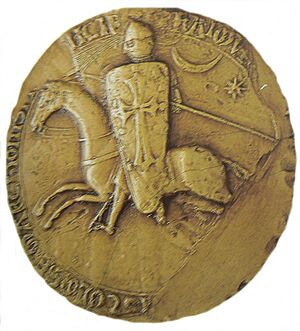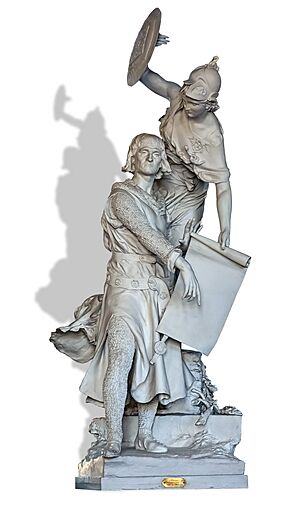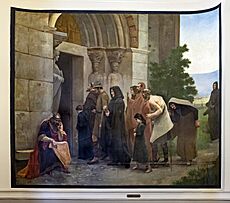Raymond VI, Count of Toulouse facts for kids
Quick facts for kids Raymond VI |
|
|---|---|

Seal of Raymond VI
|
|
| Count of Toulouse | |
| Reign | 1194–1222 |
| Predecessor | Raymond V |
| Successor | Raymond VII |
| Born | 27 October 1156 Saint-Gilles, Gard, Occitanie |
| Died | 2 August 1222 |
| Spouse |
|
| Issue | |
| House | Rouergue |
| Father | Raymond V, Count of Toulouse |
| Mother | Constance of France |
Raymond VI (born October 27, 1156 – died August 2, 1222) was a powerful ruler in medieval France. He was the Count of Toulouse and Marquis of Provence from 1194 to 1222. He also held the title of Count of Melgueil for a time. Raymond VI was known for his love of culture and his dislike of war, but he faced many challenges during his rule.
Contents
Early Life of Raymond VI
Raymond was born in Saint-Gilles, Gard. His parents were Raymond V and Constance of France. His mother's father was Louis VI of France, a king of France.
In 1194, Raymond became the Count of Toulouse after his father passed away. He quickly made peace with his neighbors, including Alfonso II of Aragon and the Trencavel family. This helped bring stability to his lands.
Raymond VI and the Church
Raymond VI became a central figure in a major conflict known as the Albigensian crusade (1209–1229). This crusade was a war against a group of Christians called the Cathars, who had different beliefs from the main Catholic Church.
Raymond ruled over a large area, but it was hard to control. He was a vassal (a ruler who owed loyalty) to both the King of France and the Holy Roman Emperor. Other powerful rulers, like Henry II of England, also had claims to parts of his territory.
In Toulouse, Raymond was popular because he supported the city's freedoms. He reduced taxes and protected the city's rights. He was a cultured man who preferred peace over fighting.
The Church, led by Pope Innocent III, wanted to stop the Cathars. They sent special representatives to the region. Raymond did not fully support these efforts, partly because many of his own people held these different beliefs. It was also hard for him to control all the towns and nobles in his lands.
One church leader, Pierre de Castelnau, was sent to deal with Raymond's tolerance for the Cathars. Pierre was killed on January 15, 1208. This event made the Pope very angry.
The Albigensian Crusade Begins
After Pierre's death, Raymond was excommunicated, meaning he was cast out of the Church. This led to the start of the Albigensian Crusade. In 1209, terrible events happened, like the massacre of Béziers and the capture of Carcassonne.
Raymond tried to make peace with Pope Innocent III, but the Pope allowed the crusade leaders to continue their war. In 1211, Raymond was excommunicated again. A powerful crusader, Simon de Montfort, began to conquer Raymond's lands, including Toulouse.
After the Battle of Muret, Raymond had to flee to England. He sought help from his former brother-in-law, John, King of England.
Fighting to Reclaim His Lands
In 1215, Raymond and his son, who would later become Raymond VII, Count of Toulouse, went to Rome. They tried to get their lands back at a big church meeting called the Fourth Lateran Council. They did not succeed at first.
Raymond and his son then traveled to Genoa and Marseille. From Marseille, Raymond's son began to fight to regain their family's lands in Provence. He successfully captured Beaucaire in 1216.
Meanwhile, Raymond went to Aragon to gather support. He secretly worked with leaders in Toulouse. In September 1217, Raymond managed to re-enter Toulouse. Simon de Montfort immediately attacked the city again.
During this siege, Simon de Montfort was killed on June 25, 1218. His son, Amaury VI of Montfort, took over, but the crusade lost its momentum. Later campaigns by the King of France also failed. This allowed Raymond and his son to slowly win back most of their territories.
Raymond VI's Death
Raymond VI became ill suddenly and could barely speak. He died in August 1222. It is said that he still understood things and showed his devotion to a church leader who came to his side. His body was taken to the home of the Brothers of the Hospital of St. John, but it was never buried.
In 1998, a medieval coffin was found in Toulouse. For a short time, people thought it might contain Raymond VI's bones. The mayor of Toulouse even asked the Pope to lift Raymond VI's excommunication, but this request was not granted.
Raymond VI's Marriages and Children
Raymond VI was married six times. Here are his wives and children:
- On December 11, 1172, he married Ermessende of Pelet. She died in 1176 without having any children.
- In 1178, he married Beatrice of Béziers. She later left him and became a nun.
- Raymond and Beatrice had one daughter:
- Constance of Toulouse. She married King Sancho VII of Navarre and later Pierre-Bermond II of Sauve.
- Raymond and Beatrice had one daughter:
- In 1193, he married Bourgogne de Lusignan. This marriage ended in 1196.
- In October 1196, he married Joan Plantagenet in Rouen. She was the daughter of Henry II of England. This marriage helped end a long conflict with the English royal family. Joan died on September 4, 1199, during childbirth.
- Joan and Raymond had three children:
- Raymond VII, Count of Toulouse (1197–1249)
- Joan of Toulouse (1198–1255)
- Richard of Toulouse (1199), who died shortly after birth.
- Joan and Raymond had three children:
- In 1200, he married a daughter of Isaac Komnenos of Cyprus. They divorced in late 1202.
- In January 1204, he married Eleanor of Aragon. She was the daughter of King Alfonso II of Aragon.
Raymond VI in Art
Raymond VI has been shown in several artworks.
One interesting depiction is on the ceiling of the Minnesota Supreme Court in the United States. Raymond VI is painted next to famous figures like Moses, Confucius, and Socrates. His painting is called "The Adjustment of Conflicting Interests." It shows him arguing for city freedoms and protection from the church in 1208. He also tried to defend religious freedom, which was a cause of the Albigensian Crusade. These paintings were created by John LaFarge in 1903.
In 1889, a painting by René-Henri Ravaut titled "Raimond VI Count of Toulouse, the excommunicated 1156-1222" was displayed in Toulouse. It shows Raymond VI left outside a church, symbolizing his excommunication.



